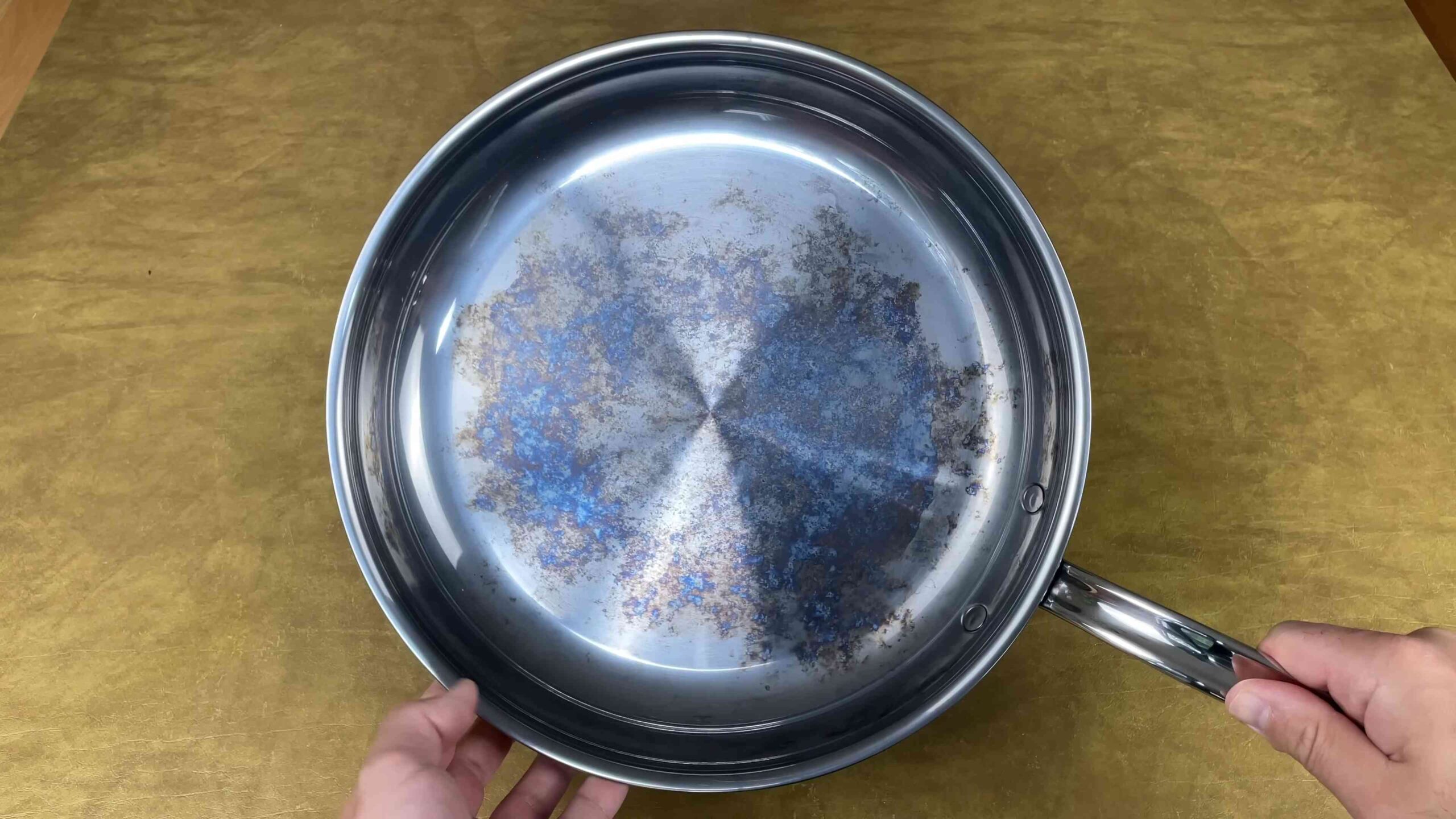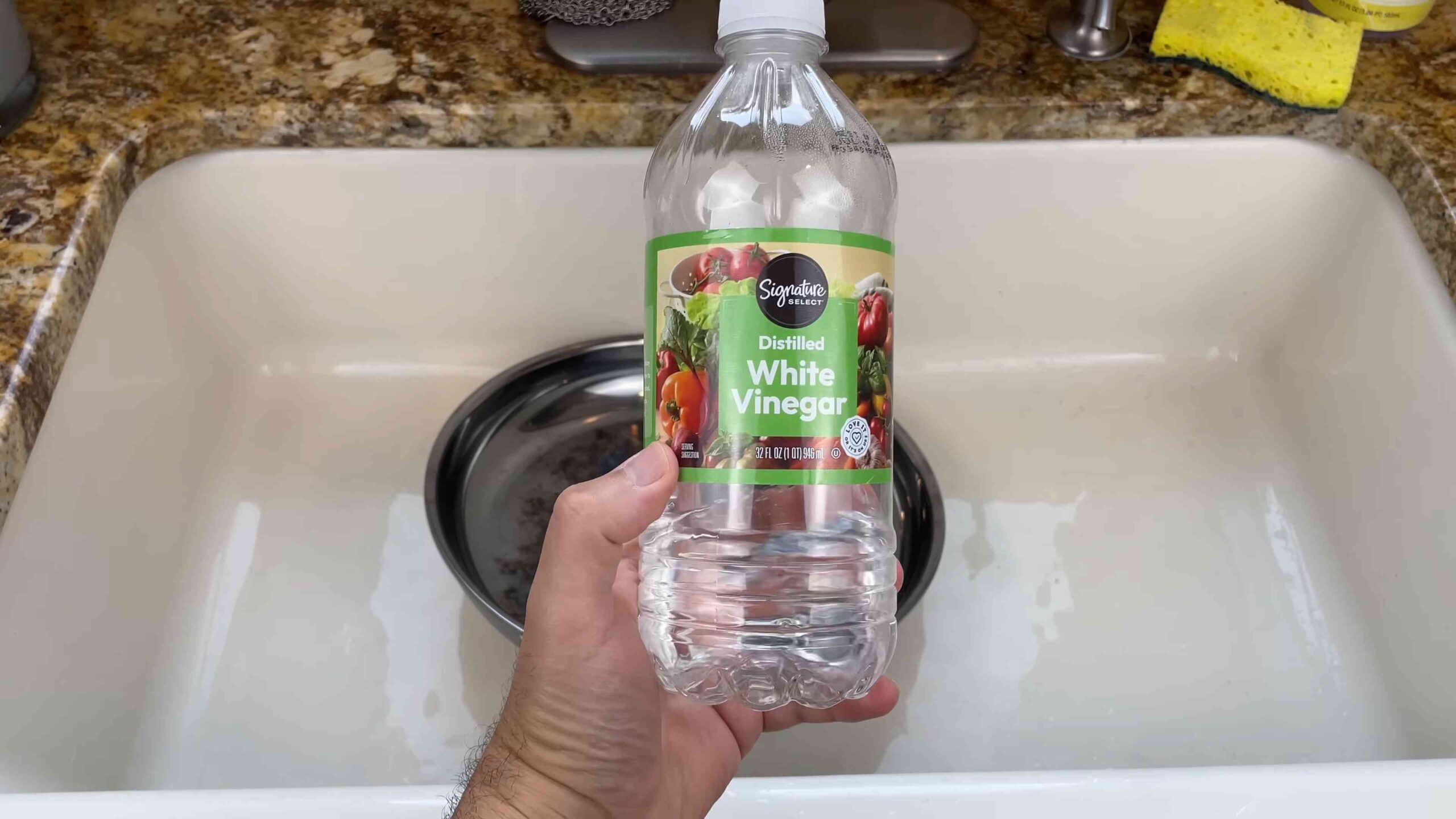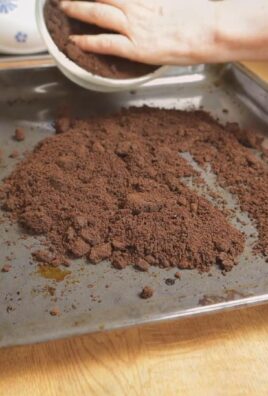Clean Stainless Steel with Vinegar: Are you tired of battling stubborn smudges and fingerprints on your beautiful stainless steel appliances? I know I am! It feels like no matter how much I wipe, those pesky marks just keep coming back. But don’t despair, because I’m about to share a simple, yet incredibly effective DIY trick that will leave your stainless steel sparkling like new – all thanks to the power of vinegar!
Vinegar, a staple in kitchens for centuries, has a rich history that extends far beyond just cooking. From ancient civilizations using it as a preservative to its modern-day applications as a cleaning agent, vinegar has proven its versatility time and time again. In fact, the Romans were known for using vinegar to clean and disinfect, a testament to its enduring effectiveness.
Why is this DIY trick so essential? Well, let’s face it, stainless steel can be a real pain to maintain. Commercial cleaners are often expensive and filled with harsh chemicals. But with this simple hack, you can achieve professional-level results using a natural, readily available ingredient. Not only will you save money, but you’ll also be reducing your exposure to potentially harmful substances. Plus, who doesn’t love the satisfaction of creating a sparkling clean home with their own two hands? So, let’s dive in and discover how to clean stainless steel with vinegar and say goodbye to those frustrating smudges for good!

DIY: Sparkling Stainless Steel with the Magic of Vinegar!
Hey there, fellow DIY enthusiasts! Are you tired of looking at dull, smudged stainless steel appliances? Do fingerprints and water spots seem to have taken permanent residence on your fridge, dishwasher, or sink? Well, fret no more! I’m here to share a super simple, incredibly effective, and budget-friendly way to bring back that showroom shine using something you probably already have in your pantry: vinegar!
This isn’t just about cleaning; it’s about restoring that sleek, modern look to your kitchen without harsh chemicals or expensive cleaners. I’ve tried countless products over the years, and trust me, this vinegar method is a game-changer. It’s gentle, safe, and leaves your stainless steel looking absolutely amazing.
What You’ll Need: Your Arsenal of Clean
Before we dive in, let’s gather our supplies. The beauty of this DIY hack is that it requires minimal tools and ingredients. Here’s what you’ll need:
* White Vinegar: The star of the show! Distilled white vinegar is your best bet.
* Spray Bottle: An empty spray bottle will make application a breeze.
* Microfiber Cloths: These are essential for streak-free cleaning. Avoid using paper towels, as they can leave lint behind.
* Soft Sponge or Cloth: For tackling stubborn spots or grime.
* Water: For rinsing and diluting the vinegar (optional).
* Optional: Olive Oil: For an extra layer of shine and protection (more on this later!).
Step-by-Step Guide: From Dull to Dazzling
Alright, let’s get down to business! Follow these steps, and you’ll be amazed at the transformation.
1. Prepare Your Vinegar Solution:
* First, grab your empty spray bottle.
* Pour undiluted white vinegar into the spray bottle. I usually use it straight, but if you’re concerned about the strong vinegar smell or have particularly sensitive stainless steel, you can dilute it with equal parts water. A 50/50 mix works perfectly fine.
* Secure the spray nozzle tightly.
2. Test in an Inconspicuous Area:
* Before you go spraying vinegar all over your appliances, it’s always a good idea to test it in a small, hidden area first. This is especially important if you’re unsure about the type of stainless steel you have.
* Spray a small amount of the vinegar solution onto the test area (like the back of your fridge or inside a cabinet).
* Wipe it with a microfiber cloth and observe for any discoloration or damage. If everything looks good, proceed to the next step.
3. Spray and Wipe:
* Now for the fun part! Lightly spray the vinegar solution onto the stainless steel surface you want to clean. Don’t over-saturate it; a light mist is all you need.
* Immediately wipe the surface with a clean microfiber cloth, following the grain of the stainless steel. This is crucial for preventing streaks.
* Important: Always wipe in the direction of the grain. You can usually see the grain lines if you look closely. Wiping against the grain will leave noticeable streaks.
4. Tackle Stubborn Spots:
* If you encounter any stubborn spots, like dried food or grease, don’t panic!
* Spray the area with a bit more vinegar solution and let it sit for a minute or two to loosen the grime.
* Use a soft sponge or cloth to gently scrub the spot. Avoid using abrasive scrubbers, as they can scratch the stainless steel.
* Wipe away the loosened grime with a clean microfiber cloth.
5. Rinse (Optional):
* If you used a lot of vinegar solution or are sensitive to the smell, you can rinse the surface with clean water.
* Simply dampen a clean microfiber cloth with water and wipe the stainless steel.
* Immediately dry the surface with another clean, dry microfiber cloth to prevent water spots.
6. Dry and Buff:
* This is the key to a truly sparkling finish! Use a clean, dry microfiber cloth to thoroughly dry and buff the stainless steel surface.
* Buffing helps to remove any remaining streaks and bring out the shine.
* Work in small sections, using circular motions to achieve a uniform finish.
Taking it to the Next Level: The Olive Oil Trick for Extra Shine
Want to take your stainless steel cleaning game to the next level? Here’s a little secret weapon: olive oil! This is an optional step, but it adds an extra layer of shine and helps to protect the stainless steel from future fingerprints and smudges.
1. Apply a Tiny Amount of Olive Oil:
* Pour a very small amount of olive oil (just a few drops) onto a clean microfiber cloth.
* Rub the cloth together to distribute the oil evenly. You want the cloth to be lightly coated, not dripping wet.
2. Wipe and Buff:
* Gently wipe the stainless steel surface with the olive oil-coated cloth, again following the grain.
* Use a clean section of the cloth to buff the surface until it’s shiny and streak-free.
* Important: Use very little olive oil. Too much will leave a greasy residue.
Maintaining Your Sparkling Stainless Steel: Tips and Tricks
Now that you’ve got your stainless steel looking its best, here are a few tips to help you maintain that shine:
* Wipe Up Spills Immediately: The sooner you wipe up spills, the less likely they are to stain or leave marks.
* Regular Cleaning: Clean your stainless steel appliances regularly, even if they don’t look dirty. A quick wipe-down once a week can prevent buildup and keep them looking their best.
* Avoid Abrasive Cleaners: Never use abrasive cleaners, steel wool, or scouring pads on stainless steel, as they can scratch the surface.
* Use the Right Cloths: Microfiber cloths are your best friend for cleaning stainless steel. They’re soft, absorbent, and won’t leave lint behind.
* Consider Stainless Steel Cleaner: While I swear by the vinegar method, there are also many excellent stainless steel cleaners available on the market. If you prefer to use a commercial cleaner, be sure to choose one that’s specifically designed for stainless steel.
* Fingerprint Resistant Coatings: Some stainless steel appliances come with fingerprint-resistant coatings. These coatings can help to reduce the appearance of fingerprints and smudges. If your appliances have this coating, be sure to follow the manufacturer’s instructions for cleaning.
* Water Quality Matters: Hard water can leave spots on stainless steel. If you have hard water, consider using filtered water for rinsing.
* Don’t Forget the Details: Pay attention to the details, such as handles, knobs, and trim. These areas can often accumulate dirt and grime.
* Ventilation is Key: When cleaning with vinegar, ensure proper ventilation to avoid inhaling excessive fumes. Open windows or use a fan.
* Be Patient: Sometimes, it takes a few tries to get your stainless steel looking perfect. Don’t get discouraged if you don’t see results immediately.
Troubleshooting: Common Issues and Solutions
Even with the best instructions, you might encounter a few hiccups along the way. Here are some common issues and how to fix them:
* Streaks: If you’re seeing streaks, make sure you’re wiping in the direction of the grain and using a clean, dry microfiber cloth. You might also be using too much vinegar solution.
* Water Spots: Water spots are usually caused by hard water. Try rinsing with filtered water or drying the surface immediately after cleaning.
* Greasy Residue: If you used the olive oil trick and ended up with a greasy residue, you probably used too much oil. Wipe the surface with a clean, dry microfiber cloth to remove the excess oil.
* Dullness: If your stainless steel still looks dull after cleaning, it might be due to a buildup of grime. Try using a soft sponge to gently scrub the surface before wiping with vinegar.
* Discoloration: If you notice any discoloration, stop using the vinegar immediately and consult a professional cleaner. This is rare, but it’s always better to be safe than sorry.
I hope this guide helps you achieve sparkling stainless steel appliances with the power of vinegar! It’s a simple, effective, and eco-friendly way to keep your kitchen looking its best. Happy cleaning!

Conclusion
So, there you have it! A simple, effective, and incredibly affordable way to achieve sparkling clean stainless steel using nothing more than everyday vinegar. Forget expensive, chemical-laden cleaners that promise the world but often leave streaks and residue. This DIY trick is a game-changer for anyone looking to maintain the beauty and longevity of their stainless steel appliances and fixtures.
Why is this a must-try? Because it’s not just about cleaning; it’s about simplifying your life. It’s about using natural, readily available resources to achieve professional-level results. It’s about saving money and reducing your environmental impact. And most importantly, it’s about taking pride in a gleaming, spotless kitchen or bathroom.
But the beauty of this method lies in its adaptability. While plain white vinegar is the star of the show, feel free to experiment with variations to suit your specific needs and preferences. For instance, if you’re dealing with particularly stubborn stains or hard water deposits, try heating the vinegar slightly before applying it. Just be sure to test it on an inconspicuous area first to ensure it doesn’t damage the surface.
Another variation involves adding a few drops of your favorite essential oil to the vinegar solution. Lavender, lemon, or tea tree oil not only add a pleasant fragrance but also boast antibacterial properties, further enhancing the cleaning power of the vinegar. Remember to use essential oils sparingly, as a little goes a long way.
For those who prefer a slightly thicker consistency, you can create a paste by mixing vinegar with baking soda. This is particularly effective for cleaning stainless steel sinks and removing baked-on food residue. Apply the paste, let it sit for a few minutes, and then scrub gently with a non-abrasive sponge.
Ultimately, the best way to discover the full potential of this DIY cleaning trick is to try it for yourself. We’re confident that you’ll be amazed by the results. The ability to clean stainless steel effectively and affordably is now within your reach.
Don’t just take our word for it. We encourage you to give this method a try and share your experience with us. Let us know what works best for you, what variations you’ve discovered, and any tips or tricks you’ve learned along the way. Your feedback is invaluable and helps us refine and improve our recommendations.
So, grab a bottle of vinegar, a soft cloth, and get ready to transform your stainless steel surfaces from dull and grimy to sparkling and pristine. You’ll be amazed at the difference it makes! We can’t wait to hear about your success stories. Happy cleaning!
Frequently Asked Questions (FAQ)
1. What type of vinegar is best for cleaning stainless steel?
Plain white distilled vinegar is generally considered the best option for cleaning stainless steel. It’s readily available, inexpensive, and effective at removing dirt, grime, and hard water stains. Avoid using other types of vinegar, such as apple cider vinegar or balsamic vinegar, as they may contain sugars or acids that could potentially damage the surface.
2. Will vinegar damage my stainless steel appliances?
When used properly, vinegar is generally safe for cleaning stainless steel. However, it’s important to dilute the vinegar with water, especially if you’re dealing with sensitive or delicate surfaces. Always test the solution on an inconspicuous area first to ensure it doesn’t cause any discoloration or damage. Avoid using vinegar on stainless steel that has a protective coating or finish, as it may strip away the coating.
3. How do I dilute the vinegar for cleaning?
A 50/50 solution of vinegar and water is usually sufficient for most cleaning tasks. For tougher stains or hard water deposits, you can use a stronger concentration of vinegar, but always test it on a small area first. You can also adjust the dilution ratio based on your personal preference and the specific needs of your cleaning project.
4. What type of cloth should I use to clean stainless steel with vinegar?
A soft, non-abrasive microfiber cloth is ideal for cleaning stainless steel with vinegar. Microfiber cloths are gentle on the surface and won’t scratch or damage the finish. Avoid using abrasive sponges or scouring pads, as they can leave scratches and swirl marks.
5. How do I prevent streaks when cleaning stainless steel with vinegar?
To prevent streaks, make sure to wipe the surface in the direction of the grain. Stainless steel has a grain, which is the direction in which the metal was polished. Wiping in the same direction as the grain will help to minimize streaks and create a more uniform finish. After wiping with the vinegar solution, dry the surface thoroughly with a clean, dry microfiber cloth.
6. Can I use vinegar to clean all types of stainless steel?
While vinegar is generally safe for most types of stainless steel, it’s always a good idea to test it on an inconspicuous area first, especially if you’re unsure about the type of stainless steel you’re dealing with. Avoid using vinegar on stainless steel that has a protective coating or finish, as it may strip away the coating.
7. How often should I clean my stainless steel appliances with vinegar?
The frequency of cleaning depends on how often you use your appliances and how dirty they get. For everyday cleaning, wiping down your stainless steel appliances with a vinegar solution once or twice a week should be sufficient. For tougher stains or spills, clean them as soon as possible to prevent them from setting in.
8. What are some other uses for vinegar in cleaning?
Vinegar is a versatile cleaning agent that can be used for a variety of tasks around the house. It can be used to clean windows, mirrors, countertops, floors, and even laundry. Vinegar is also effective at removing odors and disinfecting surfaces.
9. Can I use baking soda with vinegar to clean stainless steel?
Yes, you can create a paste by mixing vinegar with baking soda to clean stainless steel. This is particularly effective for cleaning stainless steel sinks and removing baked-on food residue. Apply the paste, let it sit for a few minutes, and then scrub gently with a non-abrasive sponge. Rinse thoroughly with water and dry with a clean cloth.
10. What if the vinegar smell is too strong?
The vinegar smell will dissipate quickly after cleaning. However, if you find the smell too strong, you can add a few drops of your favorite essential oil to the vinegar solution. Lemon, lavender, or tea tree oil are good options. You can also open a window or turn on a fan to help ventilate the area.





Leave a Comment